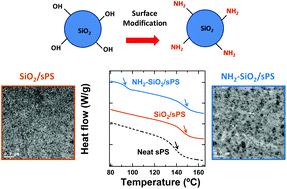Manipulating the glass transition behavior of sulfonated polystyrene by functionalized nanoparticle inclusion†
Abstract
Nanoscale interfaces can modify the phase transition behaviors of polymeric materials. Here, we report the double glass transition temperature (Tg) behavior of sulfonated polystyrene (sPS) by the inclusion of 14 nm amine-functionalized silica (NH2–SiO2) nanoparticles, which is different from the single Tg behaviors of neat sPS and silica (SiO2)-filled sPS. The inclusion of 20 wt% NH2–SiO2 nanoparticles results in an increase of Tg by 9.3 °C as well as revealing a second Tg reduced by 44.7 °C compared to the Tg of neat sPS. By contrast, when SiO2 nanoparticles with an identical concentration and size to NH2–SiO2 are dispersed, sPS composites possess a single Tg of 7.3 °C higher than that of the neat sPS. While a nanoscale dispersion is observed for SiO2 nanoparticles, as confirmed by microscopic and X-ray scattering analyses, NH2–SiO2 nanoparticles show the coexistence of micron-scale clustering along with a nanoscale dispersion of the individual nanoparticles. The micro-phase separation contributes to the free volume induced Tg reduction by the plasticization effect, whereas the Tg increase originates from the polymer segment mobility constrained by nanoconfinement and the rigid amorphous fractions deriving from strong polymer–particle interactions.


 Please wait while we load your content...
Please wait while we load your content...